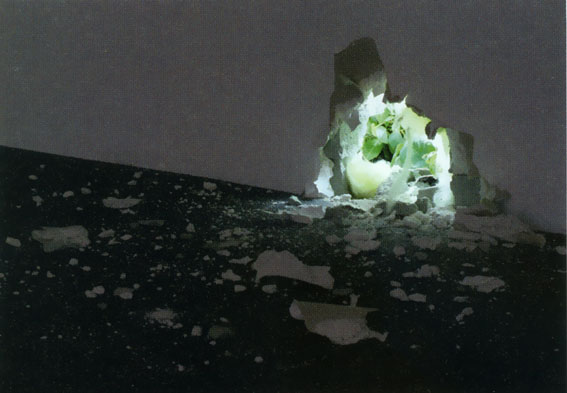

Unacabine (and the original in an FBI basement) © Kusmirowski
Why is Theodore Kaczynscki's manifesto Industrial Society and its Future, kept secret by american services alongside his memoirs ? what frightens so much the american system now he is strictly isolated under police control ?
To understand america's public ennemy,The Unabomber Book Collection by Dora Winter's collective builds up the escapist strategies while Robert Kusmirowski's Unacabine give existence to Kaczynski's flee into the wild.
The presence of his shed in the gallery space of The Palais de Tokyo challenges its legitimity : what makes the difference between the shed he lived in, the lived object, and the fake one ?
The door that asks to be opened, the incapacity to enter, deepen the mystery : the enclosed house encapsulates the uncanny nature of radicalism and extremism as a choice of life, freezing a time forever gone and inaccessible so that Kaczynski's motivations remain terra incognita, his borderline personality won't be framed.
The imperceptible nature of truth, frontiers between real and unreal, are reinforced by an empty plinth on the side of the shed where Thomas Friedman has placed A curse. The aura of the shed and the invisible malediction mirror each other's faith in the tangibility of the unseen.

Spider Hole © Christoph Buchel © Dazed & Confused
Further away, we can climb inside Christoph Buchel's Spider hole and experience how to hide - like Saddam Hussein.
Through the exhibition, escapists flee via devices - shed, hole, airvent, drain -, remain invisible from surveillance and control.

Nathaniel knows © Taro Nasu © Ryan Gander
Their disappearance suggests the existence of parallel dimensions : Ryan Gander breaks into the Palais de Tokyo as if coming from an heterotopia of wilderness, a lost hedonist paradise as the title Nathaniel knows suggests (Andre Gide, Les nourritures terrestres).

Vorkuta © Micol Assael © Andre Morin
After the critical reference to american capitalism and Napoleon's imperialism, Micol Assael's re-enactement of a communist gulag mirrors the collapse of all systems : in the absence of the worker, Vorkuta's engine is empty of its potency and those who stood in the way of the regime have disappeared.
With Paul Lafolley who explores spatial dimensions, the escape from the constraining boundaries is total. Utopia becomes a suspension between the possible and the impossible, the invisible - or para-normal - recalls the existence of multivers and their "total non-existence". When he affirms having temporary left our physical world during an electroshock in 1961, it somehow reflects Kaczynski's enforced mind control during his C.I.A. funded studies as we wonder how much the stress tests impacted on his sanity.
The chosen year 1977 - that according to the Palais de Tokyo refers to a time when the Unabomber survives by himself in his cabane in the Montana, or when Paul Laffoley finishes his odyssey, refers above all to a time zero - the birth of punk -, an apolitical, subversive dimension and collapse of values.
Now if we go back to the beginning of the show, For the dogs (...) a prelude for piano by Erick Satie and David Allen is being played on such high frequency that it can't be heard by human ear : a sound piece, and a wave field that we didn't perceive, which does exist outside our realm of senses.